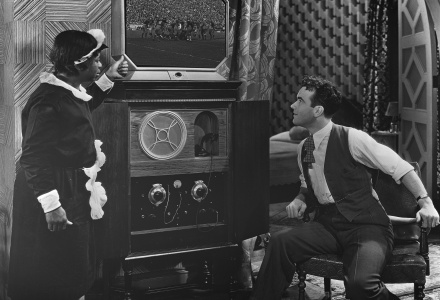The Arrival of Television
Foresight is the essence of government. The Nederlandse Bioscoopbond must have had this in mind 1936 when it added an extra clause in its contracts stating that films could not be broadcast on television without compensation.
Television found itself in an experimental phase in the 1930s. In the southern Netherlands, a number of amateurs were working on trial broadcasts, and during the 1936 Berlin Olympic Games there were live broadcasts shown in Berlin and Hamburg. These couldn’t be viewed at home, however: people gathered together in Fernsehstuben (television cafés) to watch the broadcasts. The medium developed quickly, though, and after WWII, it was unstoppable. In the Netherlands, the Nederlandse Televisie Stichting (NTS) started its broadcasts in Bussum on 2 October 1951. Before that, Philips had already experimented with broadcasts for a limited number of viewers.
At the end of the 1960s, 80% of all households in the Netherlands had a television and the medium played an important role in the daily life of the Dutch, in both the areas of news services as well as leisure time activities. Just as 60 years before when the emergence of cinema had turned the entertainment industry on its head, television’s arrival changed the Dutch daily pattern of life. The television received a central place in the living room.
Enemy...or ally?
The measures the NBB took in 1936 clearly show how apprehensive it was about television’s arrival. It seems that its initial concern wasn’t about a decrease in cinema attendance – an internal report by a committee within the NBB mentioned that, due to its technical shortcomings, television couldn’t compete with the cinema. Instead, the NBB was worried about the loss in income that it anticipated distributors would suffer. Soon enough, however, it was clear that television’s emergence was one of the most important reasons that cinema attendance figures dropped – in addition to other factors such as the changes in leisure time activities and increasing mobility.
The NBB recognised the problem and looked for a solution. It also realised it didn’t make much sense to try to compete with television. Instead, it would be better to settle for a peaceful co-existence between cinema and television, and between the NBB and the NTS. These two organisations made an agreement that television broadcasters would only screen films from distributors that were members of the NBB. Additionally, a maximum of only 60 films a year would be shown: one per week, but not on holidays or weekends, except for a few films that could be shown on Saturday afternoons. Dutch films could only be shown 40 months after they’d premiered, although exceptions could be negotiated. In this way, the NBB was able to protect the interests of its members without annoying the television companies. And besides, the NBB could always boycott the television companies by asking its members to refuse to supply them with films.
Their agreement was adjusted numerous times and there were problems when television companies acquired their own means to subtitle their broadcasts; they were no longer dependent on NBB distributors for copies of films with Dutch subtitles. They were never able to settle on an official arrangement, but ended up making a gentlemen’s agreement that continued their existing situation.
New Clients and Co-Productions
Meanwhile, television had become an important client for filmmakers. The VPRO made a name for itself in the 1960s with short documentaries related to the direct cinema movement made by Johan van der Keuken, Gied Jaspers and their associates. Beginning in the 1970s, the broadcasting companies also co-produced feature films.
In a few cases, such as with the children’s series Q en Q, a film was based on a television series, but mostly it was the other way around. In those situations, films co-produced by the broadcasting companies were released in the cinemas first and then later they were screened on television – sometimes in their entirety, other times they were adapted to miniseries, such as Ciske de rat by producer Matthijs van Heijningen and director Guido Pieters.
Telefilms Shaping Talent
In the 1980s, the cooperation between television and feature films became nearly structural. Funds were started up to help finance feature films using money from television companies. The first of these was the CoBO Fund (National Broadcasters Coproduction Fund; in Dutch: Co-BO-funds, Stichting Co-productiefonds Binnenlandse Omroep). It was started up in 1986 and its source of income is the broadcasting fees for performance rights paid by Belgian and German cable operators for the simultaneous retransmission of Dutch public television channels in their countries.
Following this, the Dutch Cultural Media Fund (Stimuleringsfonds Nederlandse Culturele Omroepproducties) was founded two years later. Every year, a portion of the advertising income from Dutch public television goes to the Media Fund. Both funds finance more than just feature films, but their contribution in this area is particularly important. This was underscored in the 1990s when the CoBO Fund and the Media Fund, together with the public television company and the Ministry of Education, Culture and Sciences, were involved with the first Dutch telefilms. These telefilms (with a maximum running time of 90 minutes) were opportunities for young directors to show their talent and gain experience.
This also gave feature films a much-needed boost: while the CV arrangement provided a financial injection, the telefilms helped shape the talents of directors such as Martin Koolhoven, Pieter Kuijpers and Nicole van Kilsdonk.
more information
If you are looking for more material from our collection, please contact Film Sales:
sales@eyefilm.nl
phone +31 (0)20 5891 426
